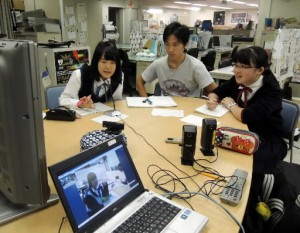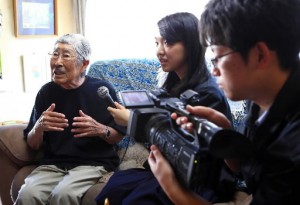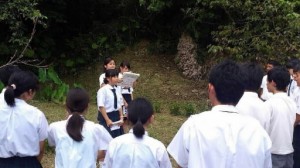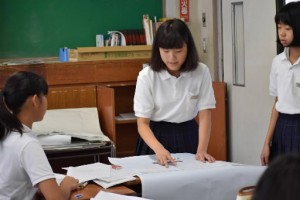Peace Seeds: Teens in Hiroshima Sow Seeds of Peace (Part 19)
Oct. 8, 2015
Part 19: Young people hand down memories of war, seeking to build a peaceful future
The junior writers for the Chugoku Shimbun listen to the accounts of A-bomb survivors, interview a range of people on peace issues, and write articles for the newspaper and website. In this report we focus on other young people who are learning about the experiences of war and, like us, are actively conveying the importance of peace.
All the high school students we interviewed were not originally interested in war and peace. They said that when they really came to realize the horror and senseless hardships of war, they wanted others to know about, and think about, these issues. At the same time, they are creating an environment where it is expected that older students will hand down their thoughts on war to younger students.
As a starting point, why not learn about how the location where you live has been impacted by war? This will offer the opportunity to consider the subject of war concretely.
Asahikawa Technical High School Broadcasting Club (Asahikawa City, Hokkaido)
Conveying an incident that occurred in Asahikawa
Each year students pursue media projects on the theme of war. Since 2007, they have made about 20 videos and radio reports for contests in which high school students create works about peace.
This year they undertook two projects. At the NHK Cup National High School Broadcasting Contest, their radio documentary Heiwa—Negai Tsuzukeru 70 Nen (Desire for Peace for 70 Years) received the encouragement award. And at the Hokkaido Video Contest for 2015, their video work, Tsutaeru, Tsutawaru—Seikatuzuga Jiken no Shogen (Accounts of the Seikatsuzuga Case) was awarded first prize.
The radio report shared the war experience of an 88-year-old former navy pilot. For 70 years he has been wrestling with guilt over having survived the war when so many others didn’t, and the students used his words “I hate war” to express these feelings. Seiya Nishikigawa, 18, a third-year student and the director of the project, said, “I hope this piece will prompt others, particularly young people of my generation, to reflect on war and peace.”
Naoya Endo, 18, a third-year student, said, “I directed the video because I wanted people to know about what really happened in Asahikawa during the war.” He conveyed the facts of the case by interviewing a man, now 93, who was involved in the incident, and using photographs from that time.
Miho Sogabe, 16, a second-year student and the head of the broadcasting club, said, “The number of people with personal experience of the war continues to shrink. I want to continue creating videos on this theme.” Throughout its history, the broadcasting club has worked on projects involving war and peace, enabling students to take greater interest in these issues. The members of the club hope that many people will have the chance to access their work via the Internet. (Nozomi Mizoue, 16, Shiho Fujii, 13, and Felix Walsh, 13)
The Seikatsuzuga Case
In September 1941, 26 students and graduates of the art club at Asahikawa Normal School (now Hokkaido University of Education, Asahikawa Campus) were arrested on suspicion of violating the Peace Preservation Law, for holding communist ideas, and 18 were indicted. They had been painting pictures about the real lives of that time.
Okinawa Shogaku Senior High School Area Studies Club (Naha City, Okinawa Prefecture)
Explaining the Shiraume Student Corps
In 2004, students at Okinawa Shogaku Senior High School made a declaration to hand down the history of the Shiraume Student Corps during the Battle of Okinawa then began their efforts to pursue this aim. They took this step because the Second Okinawa Prefectural Girls’ High School, which the members of the student corps had attended, was closed and no one else was prepared to hand down this history to future generations.
Second-year students who pass the club’s test to be a guide engage in fieldwork to trace the footsteps of the Shiraume Students Corps. Today there are ten guides. They lead high school students from other prefectures and the first-year students of the club to the school where the student corps was studying nursing and a dugout which served as a field hospital.
Hinase Nagahama, 17, a second-year student, began to see through the eyes of the old student corps because its members were around the same age. Miyuu Shiroma, 16, also a second-year student, hadn’t been aware of the existence of the student corps until she became part of the club. “I never want another war to be fought,” she said, explaining that her interest in peace issues has grown through the club’s activities.
On the other hand, the student guides sometimes struggle to clearly convey this history because they have no personal experience of the war. To help overcome this problem when they guide others, they speak directly to people who lived through the war and can share details of the conditions at that time.
The members of the club hope to raise awareness of the Shiraume Student Corps. Kaiyuu Hirata, 17, a second-year student, said, “Our generation will shape the future. I hope everyone will think of peace as a personal concern.” Memories of the war and the desire for peace is being handed down from older students to younger students. (Takeshi Iwata, 16, Haruka Shinmoto, 16, and Aoi Nakagawa, 14)
The Shiraume Student Corps
Fifty-six fourth-year students of the Second Okinawa Prefectural Girls’ High School began to be trained as nurses on March 6, 1945 and 46 of them (10 were discharged from military service because of health issues) were mobilized as assistant nurses for the army. They helped wounded soldiers with their waste, removed maggots festering in their wounds, and washed soiled bandages in a dugout which served as a field hospital. Ordered to provide medical support closer to the fighting, they moved to the front lines on June 4 and 22 members of the group lost their lives.
Nagaoka City Minami Junior High School (Nagaoka City, Niigata Prefecture)
Engaging in peace education and performing peace plays
Second-year students at Nagaoka City Minami Junior High School perform plays about the fire bombing of Nagaoka and war on the stage of the municipal theater and at the school gymnasium. The Nagaoka War Damage Museum asked the students to help hand down the experiences of World War II, and the students began performing plays to promote peace in 2010.
The students learn about peace issues at school over the course of a year. They share the experiences of people who survived the attack on Nagaoka and take part in a ceremony where lanterns are floated on the water and a peace forum held by the city. They also create newspapers that are displayed on the wall. Before performances of their plays, they make posters and publicize these events on local radio to drum up a good audience.
The second-year students are scheduled to take a three-day school trip to Hiroshima in February of next year. Sakurako Kamimura, 14, one of the second-year students, said, “I want to see the differences in the damage suffered in the war by Nagaoka and Hiroshima.”
Meanwhile, this past March the third-year students of the school performed a four-part play called Omoi, Mirai e (Our Hopes for the Future), which depicted the reconstruction of Nagaoka after the war. The play was staged at the municipal theater and included video of personal accounts of those who lived through that time. “I want to express our appreciation to the people who were involved in the reconstruction work back then,” said Ayaka Honma, who led efforts to promote the performance. “Through peace studies, I’ve come to feel strongly that we must never again engage in war and turn our city into burnt ruins. I want to carry out basic things, like not fighting and conveying what we’ve learned.”
Nobuhisa Yamamoto, 39, the teacher in charge of the peace studies program, is considering the idea of students serving as volunteer guides at the Nagaoka War Damage Museum. (Moe Nakano, 16, Kyoka Yamada, 17, and Yui Morimoto, 11)
The Bombing of Nagaoka
More than 163,000 incendiary bombs were dropped on the city of Nagaoka in Niigata Prefecture for about 100 minutes from 10:30 p.m., August 1, 1945 by 125 B-29 bombers which took off from the island of Tinian in the Pacific Ocean. About 80 percent of the city was reduced to ashes and about 1,480 people lost their lives. On July 20, 12 days before the fire bombing, a dummy atomic bomb which was almost the same shape and size as the Nagasaki A-bomb was dropped on Nagaoka, and four people died.
Junior writers’ impressions
Mr. Nishikigawa, the director of the radio program, said that he had a hard time deciding to what extent he could delve into the man’s experience, what to choose and and convey, in only seven minutes. I think he faces the same kinds of difficulties we do when asking people questions and writing articles as junior writers. So I sympathized with him. (Shiho Fujii)
I gathered information from members of the broadcasting club at Asahikawa Technical High School. I felt nervous and excited because it was my first time conducting a telephone interview. The students joined the broadcasting club without giving it much thought, but then eagerly created high-quality projects, which impressed me very much. I’d like to meet and interview more people involved in such great projects. (Felix Walsh)
I was happy to learn that junior high school students in Nagaoka, a city far from Hiroshima, watched the Peace Memorial Ceremony held in Hiroshima on August 6 on TV. I want to talk with them and learn more when they come to Hiroshima on a school trip in March. (Yui Morimoto)
As for my own experience of peace studies, I remember only that flour dumplings boiled in soup and hard biscuits were served for school lunch on July 1, the anniversary of the bombing of Kure. My school wasn’t very enthusiastic about its peace studies program. I hope that students can be involved in peace studies as part of their class time and share the experiences of people who survived air raids during the war. And I hope other cities will be encouraged to provide their junior high school students with peace education, like the city of Nagaoka. (Moe Nakano)
I was very happy to learn that students of my generation are taking action to promote peace. I was impressed that the second-year students guide the first-year students in learning about the Shiraume Student Corps, and that the younger students become interested in serving as guides, too, in their second year. I found that they’re also making efforts to widen the scope of their activities. I’d like to follow their example. (Haruka Shinmoto)
I wasn’t very interested in Okinawa because I had few chances to report about it. But this time, I was able to interview, via video chat, some young people who are also taking action and find out their thoughts. I’d like to join forces with them and take action. (Takeshi Iwata)
I sometimes think that nothing will change from the efforts made by young people, and even if they receive people education at school, they’ll just end up parroting what they heard. But in this interview, I listened to the desires of other young people who are taking action and I realized that peace education, even if students are forced to study it, can be meaningful if we reach a place where we have our own ideas. (Kyoka Yamada)
This time I interviewed students at Okinawa Shogaku Senior High School. We, the members of the younger generation, have to learn about the memories of the war so these events won’t be forgotten. I want to learn not only about Hiroshima but also the air raids that took place in other parts of Japan. (Aoi Nakagawa)
What is Peace Seeds?
Peace Seeds are the seeds of smiles which can be spread around the world by thinking about peace and the preciousness of life from various viewpoints. To fill this world with flowering smiles, 45 junior writers, from the sixth grade of elementary school to the fifth year of high school, choose themes, gather information, and write articles.
(Originally published on October 8, 2015)











